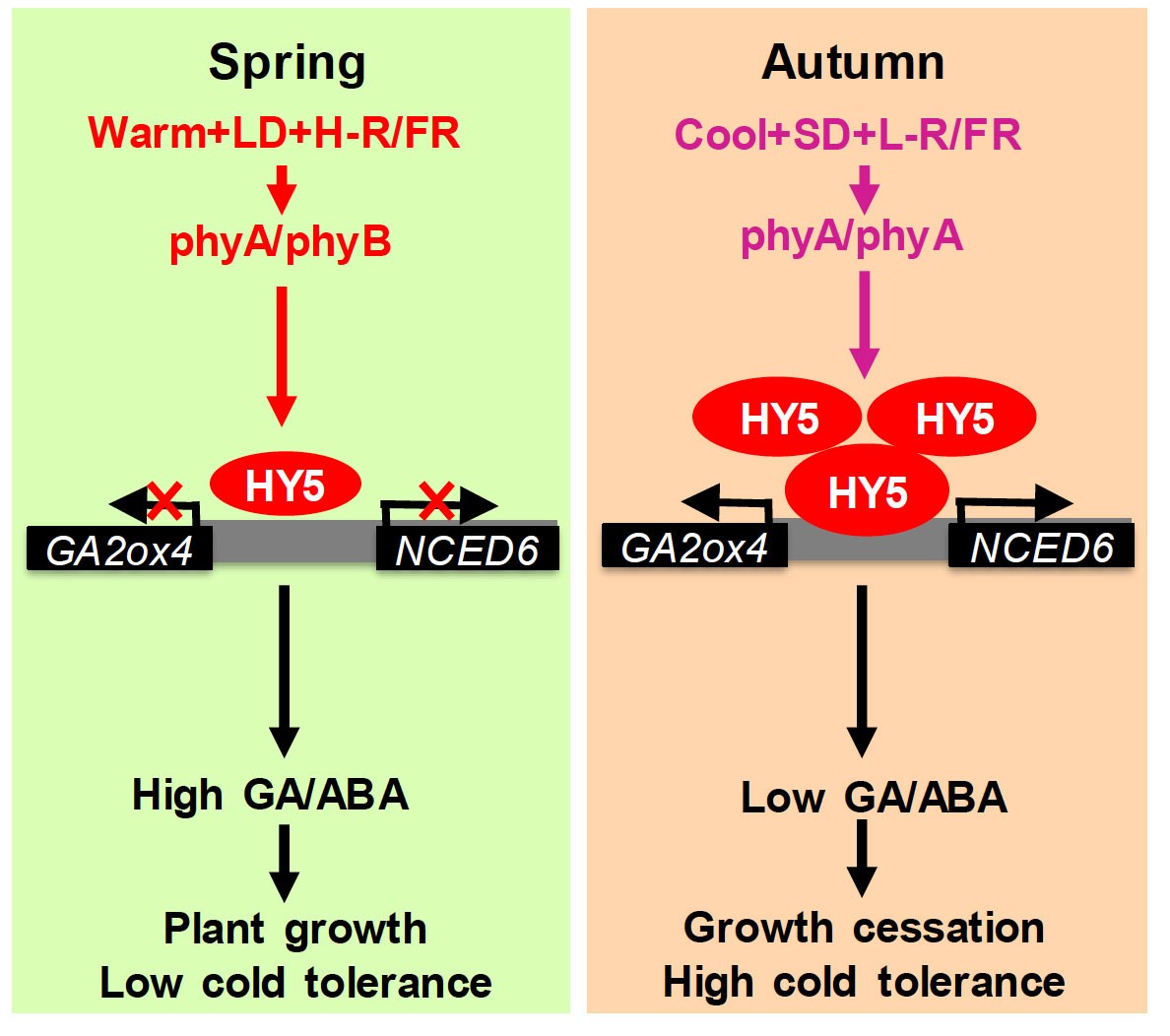博文
Plant Physiology:番茄SlHY5基因整合温度、光照和激素信号平衡植株生长和低温抗性
||
SlHY5 Integrates Temperature, Light and Hormone Signaling to Balance Plant Growth and Cold Tolerance
First author: Feng Wang; Affiliations: Zhejiang University (浙江大学): Hangzhou, China
Corresponding author: Yan-Hong Zhou
During the transition from warm to cool seasons, plants experience decreased temperatures, shortened days and decreased red/far-red (R/FR) ratios of light. The mechanism by which plants integrate these environmental cues to maintain plant growth and adaptation remains poorly understood. Here, we report that low temperature induced the transcription of PHYTOCHROME Aand accumulation of LONG HYPOCOTYL 5 (SlHY5, a bZIP transcription factor) in tomato (Solanum lycopersicum) plants, especially under short-day conditions with low R/FR light ratios. Reverse genetic approaches and physiological analyses revealed that silencing of SlHY5increased cold susceptibility in tomato plants, whereas overexpression of SlHY5enhanced cold tolerance. SlHY5 directly bound to and activated the transcription of genes encoding a gibberellin (GA)-inactivation enzyme, namely GIBBERELLIN 2-OXIDASE 4, and an abscisic acid (ABA) biosynthetic enzyme, namely 9-CIS-EPOXYCAROTENOID DIOXYGENASE 6(SlNCED6). Thus, phytochrome A-dependent SlHY5 accumulation resulted in an increased ABA/GA ratio, which was accompanied by growth cessation and induction of cold response. Furthermore, silencing of SlNCED6compromises short day- and low R/FR-induced tomato resistance to cold stress. These findings provide insight into the molecular genetic mechanisms by which plants integrate environmental stimuli with hormones to coordinate their growth with impending cold temperatures. Moreover, this work reveals a molecular mechanism that plants have evolved for growth and survival in response to seasonal changes.
�
在天气从温暖转凉时,植物经历了气温降低、日照时间变短以及红光/远红光(R/FR)比例的降低等外界环境变化。而有关于植物是如何整合这些外界的环境变化维持本身的生长发育和适应的还不是很清楚。本文中,作者报道了在番茄植株中,低温诱导了光敏色素PHYTOCHROME A基因的转录和一个bZIP转录因子SlHY5的积累,尤其在低R/FR比率的短日照条件下表现尤为明显。反向遗传学方法和生理分析表明了SlHY5的沉默会增加番茄植株的低温敏感性,而过表达SlHY5则会增强番茄植株的低温抗性。SlHY5直接结合到并激活编码赤霉素GA失活酶GIBBERELLIN 2-OXIDASE 4和一个脱落酸ABA合酶SlNCED6的表达。因此,光敏色素A依赖性的SlHY5积累导致了ABA/GA比率的增加,该过程伴随着生长停止和冷响应诱导。此外,SlNCED6沉默会减弱短日照和低R/FR比率诱导的番茄对低温胁迫的抗性。这些发现为植物整合多方面的环境刺激和激素协同调控植物在低温条件下生长的分子机理提供了新的思路。此外,本文的工作也揭示了植物演化出了适应季节变化的生长和存活的分子调控机制。
通讯:周艳虹 (https://person.zju.edu.cn/yhzhou)
研究方向:以番茄、黄瓜等设施主栽作物以及葱蒜类、茭白等特色蔬菜为研究对象,主要从事蔬菜生长发育与抗逆性调控的研究工作。
doi: https://doi.org/10.1104/pp.18.01140
Journal: Plant Physiology
First Published: 18 December, 2018
https://blog.sciencenet.cn/blog-3158122-1152575.html
上一篇:J EXP BOT:可变剪切和翻译作用于水稻种子低氧萌发
下一篇:Plant Biotechnology Journal:水稻氮营养元素的吸收与利用
全部作者的其他最新博文
- • Plant Physiology:CsMADS3促进柑果中的叶绿素降解和类胡萝卜素合成(华中农业大学)
- • Molecular Plant:LBD11-ROS反馈调节作用于拟南芥的维管形成层增殖和次生生长(浦项科技大学)
- • Science Advances:根结线虫通过调控植物的CLE3-CLV1模块,促进侵染进程(日本熊本大学)
- • Nature Communications:油菜素内酯参与植物营养生长期转变的分子机制解析(浙江农林大学)
- • Current Biology:光合作用产生的蔗糖驱动侧根“生物钟”(德国弗莱堡大学)
- • PNAS:花同源异型基因在叶中被抑制、花中被激活的分子机制(南卡罗来纳大学)

